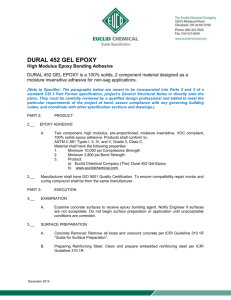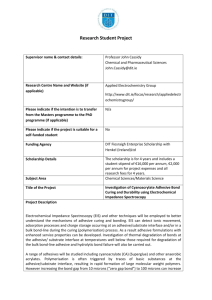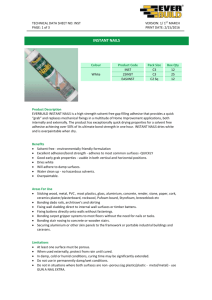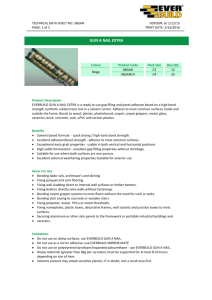Specification Bridges V-Seal Expansion Joint Systems
advertisement
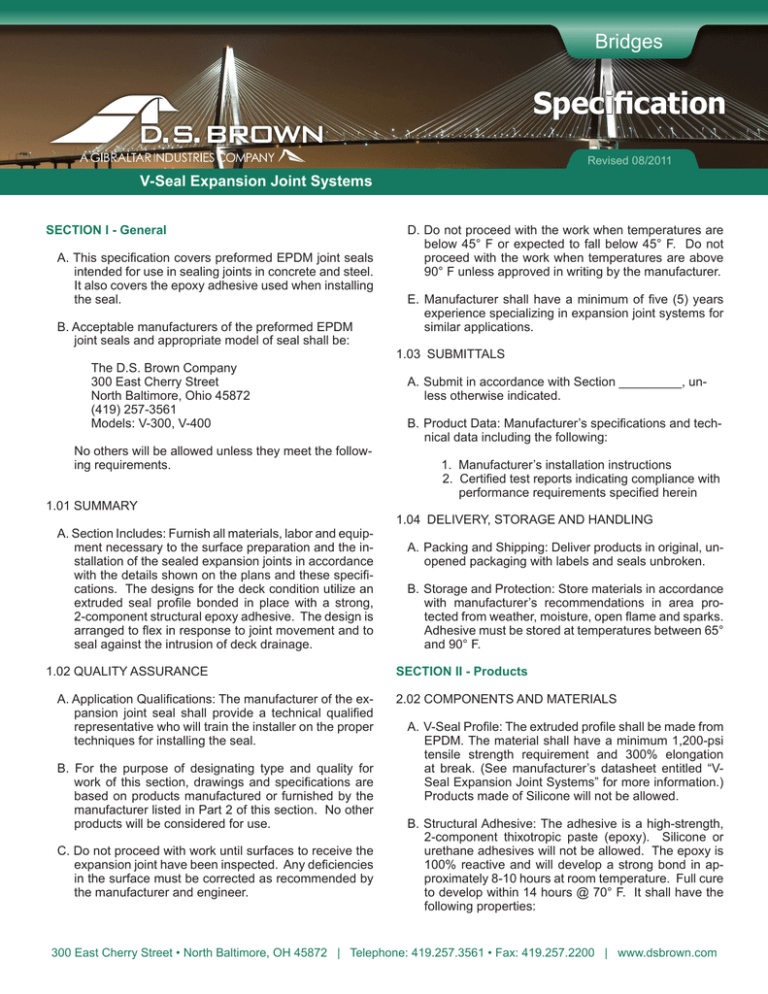
Bridges Bridges Specification Revised 08/2011 V-Seal Expansion Joint Systems SECTION I - General A. This specification covers preformed EPDM joint seals intended for use in sealing joints in concrete and steel. It also covers the epoxy adhesive used when installing the seal. B. Acceptable manufacturers of the preformed EPDM joint seals and appropriate model of seal shall be: The D.S. Brown Company 300 East Cherry Street North Baltimore, Ohio 45872 (419) 257-3561 Models: V-300, V-400 No others will be allowed unless they meet the following requirements. 1.01 SUMMARY A. Section Includes: Furnish all materials, labor and equipment necessary to the surface preparation and the installation of the sealed expansion joints in accordance with the details shown on the plans and these specifications. The designs for the deck condition utilize an extruded seal profile bonded in place with a strong, 2-component structural epoxy adhesive. The design is arranged to flex in response to joint movement and to seal against the intrusion of deck drainage. 1.02 QUALITY ASSURANCE A. Application Qualifications: The manufacturer of the expansion joint seal shall provide a technical qualified representative who will train the installer on the proper techniques for installing the seal. B. For the purpose of designating type and quality for work of this section, drawings and specifications are based on products manufactured or furnished by the manufacturer listed in Part 2 of this section. No other products will be considered for use. C. Do not proceed with work until surfaces to receive the expansion joint have been inspected. Any deficiencies in the surface must be corrected as recommended by the manufacturer and engineer. D. Do not proceed with the work when temperatures are below 45° F or expected to fall below 45° F. Do not proceed with the work when temperatures are above 90° F unless approved in writing by the manufacturer. E. Manufacturer shall have a minimum of five (5) years experience specializing in expansion joint systems for similar applications. 1.03 SUBMITTALS A.Submit in accordance with Section _________, unless otherwise indicated. B.Product Data: Manufacturer’s specifications and technical data including the following: 1. Manufacturer’s installation instructions 2. Certified test reports indicating compliance with performance requirements specified herein 1.04 DELIVERY, STORAGE AND HANDLING A.Packing and Shipping: Deliver products in original, unopened packaging with labels and seals unbroken. B.Storage and Protection: Store materials in accordance with manufacturer’s recommendations in area protected from weather, moisture, open flame and sparks. Adhesive must be stored at temperatures between 65° and 90° F. SECTION II - Products 2.02 COMPONENTS AND MATERIALS A.V-Seal Profile: The extruded profile shall be made from EPDM. The material shall have a minimum 1,200-psi tensile strength requirement and 300% elongation at break. (See manufacturer’s datasheet entitled “VSeal Expansion Joint Systems” for more information.) Products made of Silicone will not be allowed. B.Structural Adhesive: The adhesive is a high-strength, 2-component thixotropic paste (epoxy). Silicone or urethane adhesives will not be allowed. The epoxy is 100% reactive and will develop a strong bond in approximately 8-10 hours at room temperature. Full cure to develop within 14 hours @ 70° F. It shall have the following properties: 300 East Cherry Street • North Baltimore, OH 45872 | Telephone: 419.257.3561 • Fax: 419.257.2200 | www.dsbrown.com Bridges Bridges Specification V-Seal Expansion Joint Systems Typical Physical Property Resin Part A Hardener Part B Appearance White Black paste Viscosity (cps) 300,000-700,000 300,000-700,000 Non-volatile Content 100% Reactive 100% Reactive Shelf life from date of shipment when stored in unopened container @ 40° - 80° F 1 Year 1 Year Tensile strength ASTM D638 8000 PSI Bond strength to concrete ASTM C881 3000 PSI Bond strength to steel ASTM D1002 1800 PSI Pot life 45 minutes SECTION III - EXECUTION 3.02 PREPARATION OF SURFACES OF BLOCKOUT RECESS IN DECK A.All surfaces to receive the V-Seal profile shall be dry, clean and sound concrete free of loose, cracked, delaminated and spalled sections. Repair any sections that do not meet the criteria. The surfaces to receive the seal profile shall be sandblasted to exposed aggregate or to near white metal blast on steel shapes. Sandblasting increases surface area to increase bond capacity of the adhesive, as well as removing all laitance and other bond-inhibiting contaminants. 3.03 PREPARATION OF JOINT INTERFACES 2 of 2 should be blown out again. The manufacturer’s cleaner should be applied to concrete or steel surfaces. B.Uncoil the seal and allow it to relax. Apply the conditioning agent to bottom and top of the lug. Wire brush or lightly sandblast the surface to receive the epoxy adhesive. When done properly, the shine of the surfaces will be removed and a roughened, dull, tacky finish will be obtained. Then apply the rubbing/denatured alcohol scrubbing vigorously into the ribs using a stiff nylon brush or clean alcohol-soaked rags. C.OPTIONAL: Install a properly sized backer rod to hold the V-seal to ¼” below the maximum compressed height. D.Mix the adhesive to the manufacturer’s specifications. Apply a 3/8” bead of epoxy adhesive to the underside edges of the V-seal or along the edges of the backer rod. E.Insert the profile in the gap to the proper depth. Fill in epoxy adhesive to cover the ribs for proper adhesive coverage. Tool the adhesive to fill any voids. A small amount of excess adhesive should be visible above the ribbed area. Remove any additional adhesive using organic solvents. F. Allow the adhesive to cure 8-10 hours (at room temperature). Maximum bond strength (at room temperature) is usually achieved within 14 hours. 3.05 FIELD QUALITY CONTROL A.Work that does not conform to the specified requirements shall be corrected and/or replaced as directed by the manufacturer and engineer. END OF SECTION A. Ensure that the interfaces, whether concrete or steel, run parallel to each other for the length of the run. Walls should be plum to the top surface of the concrete and should be spaced at a consistent width across the joint. Unsound concrete shall be removed and repaired. B. Clean dirt, stones and standing water from the joint opening. Use a stiff bristled brush and compressed air to remove all dust. Sandblast the vertical walls of the groove to remove laitance and contaminants, and to increase the bond area for the adhesive. 3.04 INSTALLATION OF THE SEAL PROFILE A.Immediately prior to installation, the interface walls 300 East Cherry Street • North Baltimore, OH 45872 | Telephone: 419.257.3561 • Fax: 419.257.2200 | www.dsbrown.com

